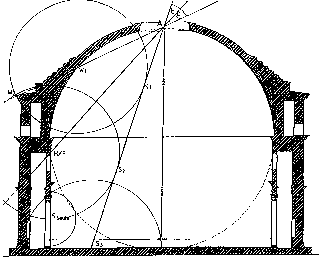The
Quadrivium in the Pantheon of Rome
Gert Sperling
Fuldatal, GERMANY
 "The
Pantheon complex has been the object of countless interpretations.
There is no certainty as to how and why it was created and what
it is meant to express, because there are no documents concerning
the identity of the architect, the exact dates of conception,
its origin or its function. Since ancient times we find vague
references to its symbolic function: according to Dio Cassius,
it resembles the heavens. But the cosmological interpretations
do not take into consideration the real metrical dimensions of
the whole complex nor the relation between its numbers, shapes,
forms and proportions. Even the modules are identified very differently,
so that it is difficult to compare the various analyses.
"The
Pantheon complex has been the object of countless interpretations.
There is no certainty as to how and why it was created and what
it is meant to express, because there are no documents concerning
the identity of the architect, the exact dates of conception,
its origin or its function. Since ancient times we find vague
references to its symbolic function: according to Dio Cassius,
it resembles the heavens. But the cosmological interpretations
do not take into consideration the real metrical dimensions of
the whole complex nor the relation between its numbers, shapes,
forms and proportions. Even the modules are identified very differently,
so that it is difficult to compare the various analyses.
Some scholars take the Neopythagorean roots of the Pantheon
seriously, interpreting the architecture as an integrated visualization
of the Greek mathematically-conceptualized theory of the cosmos,
which consisted of an amalgamation of cosmological, geodetical
and anthropomorphical dimensions. To generate harmony, the laws
of arithmetic, geometry, astronomy and musical-proportions are
fused. The pantheon can be considered an architectural image of
the Pythagorean cosmos, a "living organism" with a mathematically-proportioning
"soul" and unchanging, "eternal" consonant-symphonic
ratios. It "resembles the heavens", but is a resemblance
based on mathematical knowledge, a summary of the ancient quadrivium."
Order the book Nexus II: Architecture
and Mathematics
| abstract
index | previous |
next | NNJ homepage | e-mail
Gert Sperling | top of page
 "The
Pantheon complex has been the object of countless interpretations.
There is no certainty as to how and why it was created and what
it is meant to express, because there are no documents concerning
the identity of the architect, the exact dates of conception,
its origin or its function. Since ancient times we find vague
references to its symbolic function: according to Dio Cassius,
it resembles the heavens. But the cosmological interpretations
do not take into consideration the real metrical dimensions of
the whole complex nor the relation between its numbers, shapes,
forms and proportions. Even the modules are identified very differently,
so that it is difficult to compare the various analyses.
"The
Pantheon complex has been the object of countless interpretations.
There is no certainty as to how and why it was created and what
it is meant to express, because there are no documents concerning
the identity of the architect, the exact dates of conception,
its origin or its function. Since ancient times we find vague
references to its symbolic function: according to Dio Cassius,
it resembles the heavens. But the cosmological interpretations
do not take into consideration the real metrical dimensions of
the whole complex nor the relation between its numbers, shapes,
forms and proportions. Even the modules are identified very differently,
so that it is difficult to compare the various analyses.